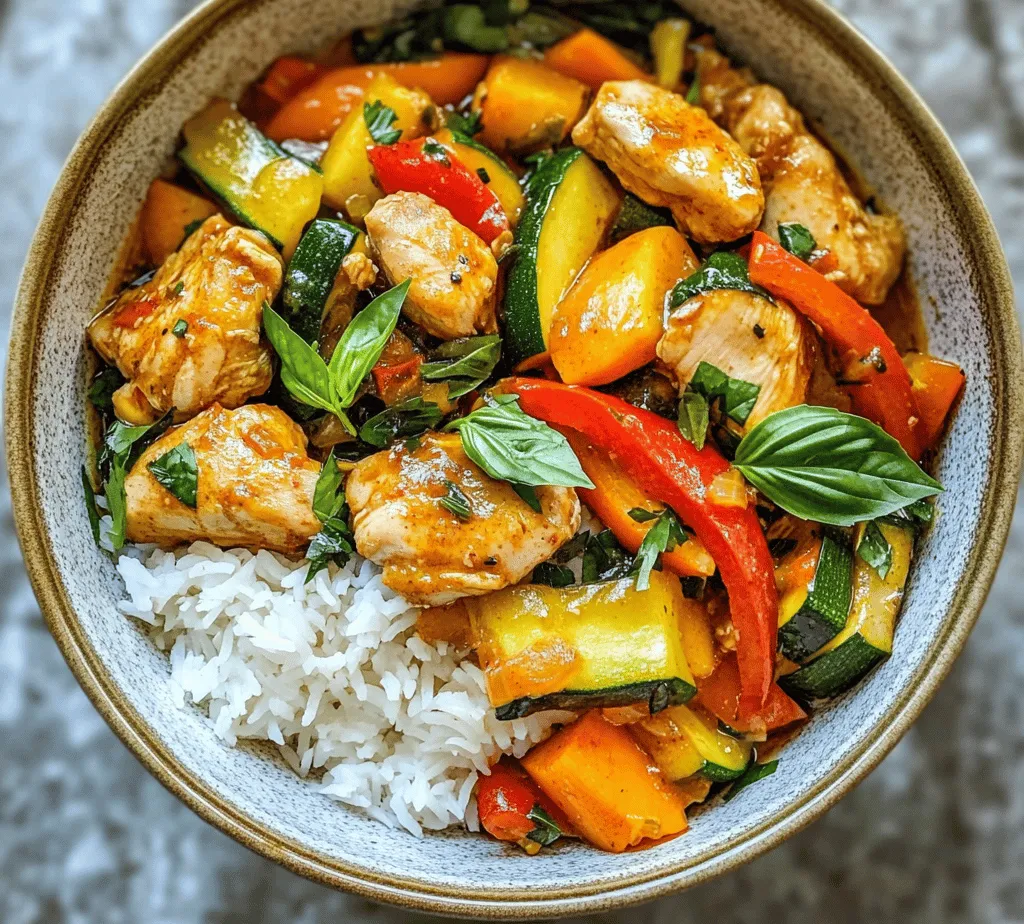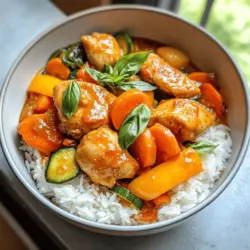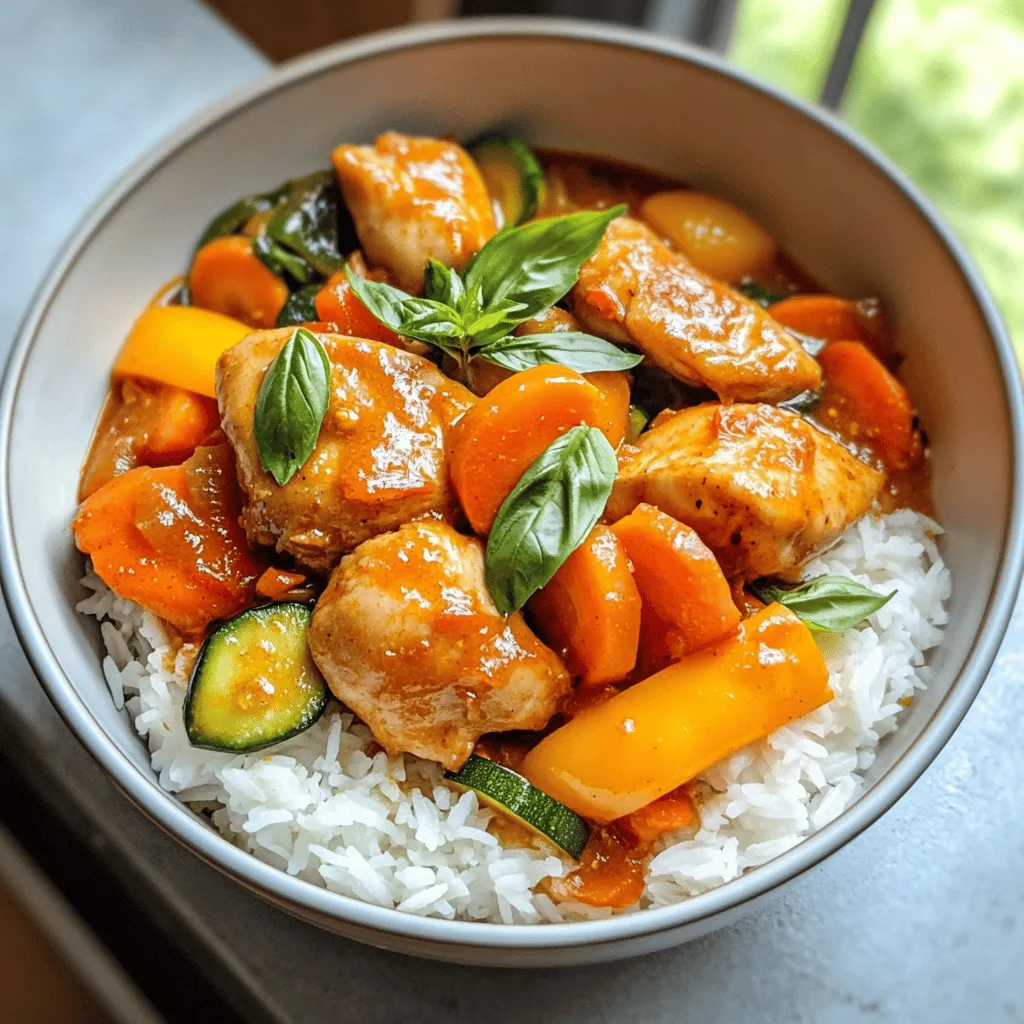Thai cuisine is celebrated for its vibrant flavors and comforting dishes, often characterized by a harmonious balance of spices, herbs, and fresh ingredients. Among the myriad of delicious offerings, Thai Chicken Curry with Coconut Milk stands out as a favorite for many. This dish not only showcases the rich culinary traditions of Thailand but also embodies the essence of comfort food. With its creamy coconut base and aromatic spices, it promises to deliver a delightful dining experience that is both satisfying and nourishing.
The beauty of Thai Chicken Curry lies in its ability to strike a perfect balance between sweet, savory, and spicy flavors. Coconut milk brings a luscious creaminess that enriches the curry, while the red curry paste infuses it with a depth of flavor that tantalizes the taste buds. The addition of colorful vegetables not only enhances the dish’s visual appeal but also contributes a variety of textures and nutrients, making it a wholesome meal for families and gatherings alike.
In this article, we will guide you through every step of preparing this delightful Thai Chicken Curry, ensuring that you can recreate this restaurant-quality dish at home. From understanding the key ingredients to detailed cooking instructions, we will cover everything you need to know to impress your family and friends with your culinary skills.
Understanding the Ingredients
The secret to any great dish lies in its ingredients, and Thai Chicken Curry is no exception. Each component plays a crucial role in creating the unique flavor profile that this dish is known for. Let’s explore the essential ingredients that come together to create this mouthwatering curry.
Boneless Chicken Thighs
When it comes to chicken curry, boneless chicken thighs are often the preferred choice. Unlike chicken breasts, which can dry out easily, chicken thighs remain juicy and tender during the cooking process. Their slightly higher fat content adds richness to the curry, enhancing the overall flavor. Additionally, chicken thighs absorb the spices and coconut milk beautifully, making each bite a burst of deliciousness. For the best results, look for fresh or high-quality frozen chicken thighs that can be easily cut into bite-sized pieces.
Coconut Milk
Coconut milk is the star ingredient of Thai Chicken Curry, providing a creamy texture that envelops the chicken and vegetables. It also lends a subtle sweetness that balances the heat from the curry paste. Beyond its delightful taste, coconut milk is rich in healthy fats, particularly medium-chain triglycerides (MCTs), which can provide a quick source of energy. When selecting coconut milk, aim for full-fat varieties for a richer, more indulgent curry. However, light coconut milk can be used for a lighter option without sacrificing too much flavor.
Red Curry Paste
Red curry paste is the heart of this dish, delivering the signature flavor that defines Thai curries. This vibrant paste is made from a blend of red chili peppers, garlic, shallots, lemongrass, galangal, and various spices, resulting in a complex flavor profile that ranges from spicy to aromatic. It is essential to sauté the curry paste before adding other ingredients, as this process releases the essential oils and intensifies the flavor. You can find red curry paste in most grocery stores, or alternatively, make your own at home for a fresher taste.
Mixed Vegetables
Colorful mixed vegetables are not only visually appealing but also add nutritional value to the dish. Common choices include bell peppers, zucchini, and carrots, which contribute a variety of textures and flavors. Bell peppers add a sweet crunch, zucchini brings a subtle earthiness, and carrots provide a natural sweetness that complements the spices. Feel free to customize the vegetable selection based on what’s in season or your personal preferences; snap peas, broccoli, and baby corn are also excellent additions that can enhance the dish.
Seasonings and Accompaniments
To round out the flavors of the curry, several seasonings and accompaniments come into play. Fish sauce adds a salty umami depth that enhances the overall flavor without overpowering it. Brown sugar introduces a hint of sweetness, counterbalancing the heat from the curry paste. A splash of fresh lime juice brightens the dish and elevates the flavors, making it more vibrant. Lastly, serving the curry with jasmine rice is traditional and practical, as the rice helps to absorb the rich sauce, providing a satisfying meal that is sure to please.
Step-by-Step Instructions for Preparing Thai Chicken Curry
Now that we have a solid understanding of the key ingredients, let’s dive into the step-by-step instructions for preparing this delectable Thai Chicken Curry with Coconut Milk. Follow these detailed steps to ensure your curry turns out perfectly every time.
Sautéing the Curry Paste
Start by preparing your ingredients and gathering all necessary tools, including a large skillet or wok. Heat a tablespoon of oil over medium heat. Once the oil is hot, add the red curry paste to the pan. Sauté the paste for about 1-2 minutes, stirring frequently. This step is crucial as it releases the aromatic oils from the herbs and spices, intensifying the flavors. You will notice the paste becoming fragrant and slightly darker in color, a sign that it’s ready for the next steps.
Cooking the Chicken
Next, add the boneless chicken thighs to the skillet. Make sure to cut the chicken into uniform bite-sized pieces to ensure even cooking. Increase the heat to medium-high and sear the chicken for about 5-7 minutes, stirring occasionally. This will help develop a nice golden-brown crust on the chicken, enhancing its flavor. Once the chicken is cooked through and no longer pink in the center, it’s time to move on to the next step.
Incorporating Coconut Milk and Chicken Broth
Now, it’s time to create the rich sauce that will envelop the chicken. Pour in the coconut milk and chicken broth, stirring to combine with the sautéed curry paste. The combination of these two liquids creates a luscious and creamy sauce that is the hallmark of Thai curries. Allow the mixture to come to a gentle simmer, reducing the heat if necessary. This simmering process will allow the flavors to meld together beautifully.
Adding the Vegetables
Once the sauce is simmering, it’s time to incorporate the mixed vegetables. Add the bell peppers, zucchini, and carrots to the skillet, stirring to coat them in the sauce. This ensures that they absorb the flavors while still retaining their crunch. To achieve the perfect texture, add the vegetables in stages; for instance, add carrots first, as they take longer to cook, followed by bell peppers and zucchini. Simmer the curry for an additional 5-7 minutes, or until the vegetables are tender yet crisp.
Seasoning the Dish
As the curry simmers with the vegetables, it’s important to season the dish to enhance its flavor. Start by adding a splash of fish sauce, which provides a salty umami kick, followed by a teaspoon of brown sugar to balance the flavors. Adjust the quantity based on your taste preference, as some may prefer a sweeter curry. Finally, squeeze in the fresh lime juice, which will brighten the dish and add a refreshing zing. Taste the curry and make any adjustments as necessary, ensuring a well-rounded flavor profile.
With these initial steps, you are well on your way to creating a delicious Thai Chicken Curry with Coconut Milk. This recipe not only allows for creative expression in terms of ingredient choices but also provides an opportunity to share the rich flavors of Thai cuisine with your loved ones. As you continue through the cooking process, you will find that the aromas filling your kitchen are truly irresistible, setting the stage for a delightful meal that is sure to impress. Stay tuned as we delve deeper into additional tips and tricks for achieving the perfect curry.

Serving Suggestions
When it comes to serving your Thai Chicken Curry with Coconut Milk, presentation plays a pivotal role in enhancing the dining experience. Start by ladling generous portions of the vibrant curry into shallow bowls, allowing the colorful ingredients to shine through. A sprinkle of fresh basil leaves not only adds a pop of color but also a fresh aroma that complements the dish beautifully. For an extra touch of sophistication, consider drizzling a few drops of coconut milk on top of the curry, creating an appealing marbled effect.
Pair your curry with a side of fluffy jasmine rice or fragrant coconut rice to absorb the delicious sauce. You might also serve it alongside a crisp green salad dressed in a light vinaigrette to balance the richness of the curry. For those who enjoy a bit of crunch, fried shallots or toasted peanuts can be added as a garnish, providing a delightful textural contrast.
Nutritional Benefits of Thai Chicken Curry
Thai Chicken Curry with Coconut Milk is not only a feast for the senses but also a well-rounded meal packed with nutritional benefits.
Protein from Chicken
Chicken is a staple in many cuisines, renowned for being a lean source of protein. In this recipe, the chicken provides essential amino acids necessary for muscle repair and overall health. Incorporating chicken into your diet can help maintain a healthy weight and support immune function. Opting for skinless chicken breast is an excellent way to minimize fat intake while maximizing protein consumption, making your curry not only delicious but also a healthy choice.
Healthy Fats from Coconut Milk
Coconut milk is another highlight of this dish, offering a creamy texture and rich flavor. It’s rich in medium-chain triglycerides (MCTs), which are known for their unique nutritional properties. Unlike long-chain fatty acids, MCTs are metabolized differently; they can be quickly converted into energy rather than stored as fat. Additionally, coconut milk contains lauric acid, which has antimicrobial properties that can support immune health. Despite its richness, coconut milk can be part of a balanced diet when consumed in moderation, bringing both flavor and health benefits to your curry.
Vitamins and Minerals from Vegetables
The variety of vegetables included in your Thai Chicken Curry contributes significantly to its nutritional profile. Bell peppers, carrots, and zucchini add not only color but also an array of vitamins and minerals. For instance, bell peppers are high in vitamin C, which supports the immune system, while carrots provide beta-carotene, essential for eye health. Incorporating a range of vegetables ensures that you receive a broad spectrum of nutrients, including antioxidants that help combat oxidative stress in the body. The combination of lean protein, healthy fats, and a medley of vegetables makes this curry a wholesome choice for any meal.
Cultural Significance of Thai Curries
Thai curry holds a special place in the heart of Thai cuisine, reflecting the rich cultural heritage and culinary traditions of the region.
Origins of Thai Curry
The origins of Thai curry can be traced back to ancient times when spices and herbs were fundamental components of Thai cooking. Influences from neighboring countries, such as India and Malaysia, introduced various spices that transformed local recipes. Thai curries evolved into distinct regional variations, each with its unique flavor profiles and ingredients. For example, while red curry paste is popular in central Thailand, green curry is often associated with the north, characterized by its vibrant green color from fresh herbs and chilies.
Role of Curry in Thai Meals
In Thai households, curry is more than just a dish; it’s a symbol of communal dining and sharing. Traditionally, a meal consists of several dishes served family-style, allowing everyone to enjoy a bit of everything. Thai curry is often accompanied by rice, helping to balance the flavors and textures. The communal aspect of dining fosters a sense of togetherness, making curry an integral part of celebrations and everyday meals alike. This cultural significance adds depth to the experience of enjoying a homemade Thai Chicken Curry.
Variations of Thai Chicken Curry
One of the beautiful aspects of cooking is the ability to adapt recipes to fit different dietary preferences and tastes. Thai Chicken Curry is no exception, and there are many variations to explore.
Vegetarian and Vegan Alternatives
For those looking to enjoy a plant-based version of Thai curry, there are plenty of delicious substitutes for chicken. Tofu is a fantastic option, absorbing the flavors of the curry while adding a satisfying texture. Alternatively, you can use chickpeas or a mix of hearty vegetables like eggplant, mushrooms, and cauliflower for a robust and fulfilling dish. When making a vegetarian or vegan curry, consider using vegetable broth instead of chicken broth and ensure that your curry paste does not contain shrimp paste, which is common in some brands.
Spiciness Levels
Adjusting the heat level of your Thai Chicken Curry is simple and can be tailored to individual preferences. The amount of curry paste used is the primary factor in determining the spiciness of the dish. For a milder flavor, start with a smaller amount of the paste and gradually add more until you reach the desired heat. You can also include fresh chilies, adjusting the variety based on your tolerance for spice. Remember, it’s easier to add heat than to tone it down, so proceed with caution!
Different Types of Curry Pastes
Thai curry pastes come in various types, each offering unique flavor profiles. The most commonly used are red, green, and yellow curry pastes. Red curry paste is made from red chilies, garlic, lemongrass, and shrimp paste, resulting in a bold and spicy flavor. Green curry paste, on the other hand, is made from fresh green chilies, giving it a distinctive bright color and a fresh, herbal taste. Yellow curry paste is milder and typically includes turmeric, giving the curry a warm golden hue. Experimenting with different types of curry pastes can lead to exciting flavor variations in your dish.
Conclusion: Embracing Homemade Thai Chicken Curry
Homemade Thai Chicken Curry with Coconut Milk is more than just a meal; it’s an experience that brings warmth, flavor, and nourishment to the table. The combination of tender chicken, creamy coconut milk, and vibrant vegetables creates a dish that is both satisfying and wholesome. Embracing the cooking process allows you to infuse your own creativity and preferences into the recipe, making it uniquely yours.
As you prepare this delightful curry, take pleasure in the aromatic spices and vibrant colors that fill your kitchen. Share your creation with family and friends, fostering connection and enjoyment through food. Whether you’re serving it during a special occasion or as a comforting weeknight dinner, your homemade Thai Chicken Curry is sure to impress and satisfy. So gather your ingredients, follow the steps, and relish in the joy of cooking and sharing a dish that embodies the heart of Thai cuisine.


